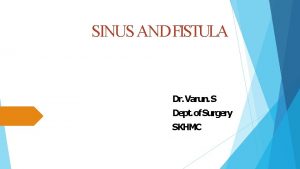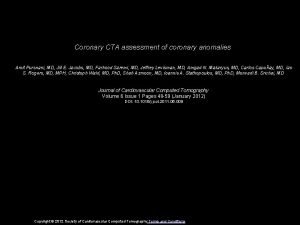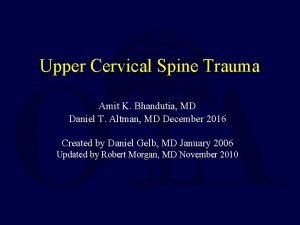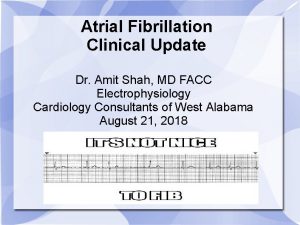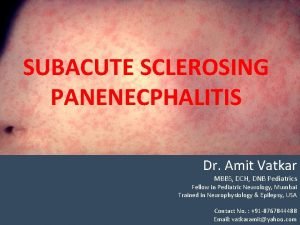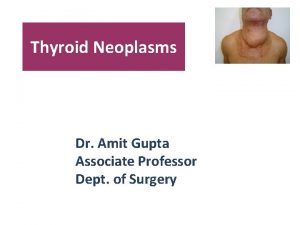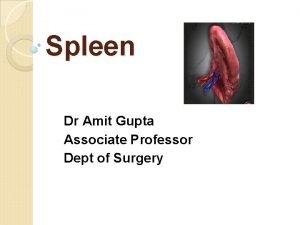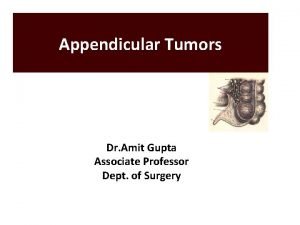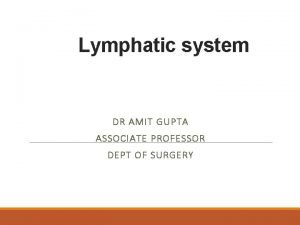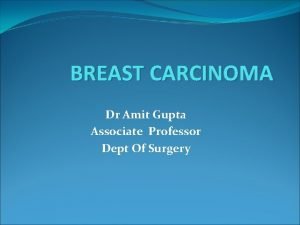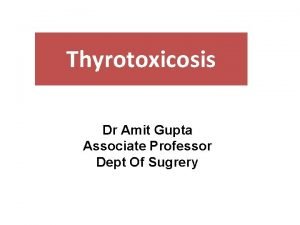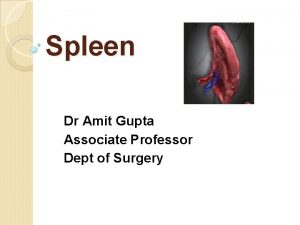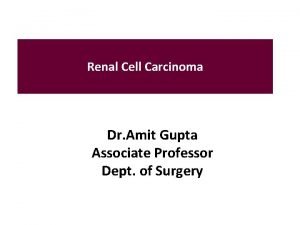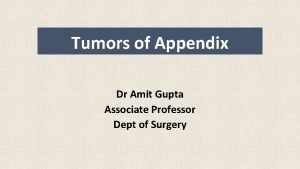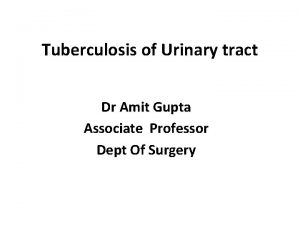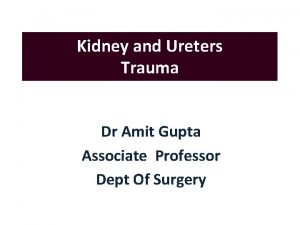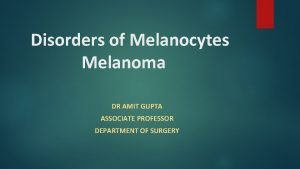Lymphangitis Lymphadenitis Dr Amit Gupta Associate Professor Dept



































- Slides: 35

Lymphangitis Lymphadenitis Dr Amit Gupta Associate Professor Dept Of Surgery

Introduction • Lymphatic system encompasses a network of vessels, glands, and organs located throughout the body. • Transports fluids, fats, proteins, and other substances in the body. • Lymph nodes filter the lymph fluid. • Foreign bodies such as bacteria and viruses are processed in the lymph nodes to generate an immune response to fight infection.


When pathogenic organisms enter the lymphatic channels local inflammation and subsequent infection ensue, manifesting as red streaks on the skin. The inflammation or infection then extends proximally toward regional lymph nodes. Bacteria can grow rapidly in the lymphatic system

Definition Inflammation of the lymphatic channels that occurs as a result of infection at a site distal to the channel

Etiology • • Species of group A beta-hemolytic streptococci (GABHS) (MC) Staphylococcus aureus Pseudomonas species Streptococcus pneumoniae Pasteurella multocida Gram-negative rods, gram-negative bacilli, and fungi Aeromonas hydrophila Wuchereria bancrofti Diabetes, immunodeficiency, varicella, chronic steroid use, or other systemic illnesses have increased risk of developing serious or rapidly spreading lymphangitis.

Nodular lymphangitis Superficial inoculation with one of the following organisms: – – – Sporothrix schenckii Nocardia brasiliensis Mycobacterium marinum Leishmania panamensis L guyanensis Francisella tularensis

Prognosis • With uncomplicated lymphangitis is good. • Antimicrobial regimens are effective in more than 90% of cases. • Without appropriate antimicrobial therapy cellulitis may extend along the channels; necrosis and ulceration may occur. • Morbidity and mortality is related to the underlying infection. • Mortality associated with lymphangitis alone, lymphangitis caused by GABHS can lead to bacteremia, sepsis, and death.

Clinical presentation • H/o minor trauma to an area of skin distal to the site of infection • Children with lymphangitis: fever, chills, and malaise, headache, loss of appetite, muscle aches. • H/o recent cut or abrasion or of an area of skin • Can progress rapidly to bacteremia and disseminated infection and sepsis


Physical examination • Erythematous and irregular linear streaks extend from the primary infection site toward draining regional nodes. • Primary site may be an abscess, an infected wound or an area of cellulitis • Blistering of the affected skin may occur • Lymph nodes associated with the infected lymphatic channels are often swollen and tender • Patients may be febrile and tachycardic

Differential diagnosis • Contact dermatitis • Cellulitis • Septic thrombophlebitis • Superficial thrombophlebitis • Necrotizing fasciitis • Myositis • Sporotrichosis

Investigations • Complete blood cell (CBC) count • Blood culture • Leading -edge culture or aspiration of pus • Cultures and Gram staining of fluid. Threshold sensitivity of Gram staining: 100, 000 microorganisms per milliliter, concentration rarely found in cellulitis or lymphangitis.

A study found that multidetector computed tomography (MDCT) imaging was very useful in determining the morphology (cellulitis with a few small subcutaneous nodules and channels) and the extension of the lesion in a case of nodular lymphangitis caused by Mycobacterium marinum

Management • Antibiotics • Oral • Parenteral (with signs of systemic illness (eg, fever, chills and myalgia, lymphangitis). • Analgesics • Anti -inflammatory • Elevation and immobilization of affected areas reduces swelling, pain, and the spread of infection. An abscess may require surgical drainage.

Nodular lymphangitis • Treatment of nodular lymphangitis is determined by identifying the underlying cause. • Sporotrichosis is most often identified in this disease and is commonly found among gardeners.

Antibiotics • • Dicloxacillin Cephalexin Cefazolin Cefuroxime Ceftriaxone Clindamycin Nafcillin Trimethoprim and sulfamethoxazole (TMP/SMZ)

Lymphadenitis

Lymphadenitis acute or chronic Rarely biopsied Classification pattern etiology predominant histologic

Lymphadenitis - etiology Microbial • viral • bacterial, mycobacterial • fungal • Protozoal Nonmicrobial Autoimmune storage disease

Lymph node inflammation Lymph node hyperplasia: 1. follicular 2. paracortical 3. sinuses 4. mixed patterns

Lymph node inflammation - patterns • Follicular hyperplasia bacteria, RA, HIV(early), syphilis, Castleman dis. • Paracortical hyperplasia viruses, dermatopathies, vaccination, drug hypersensitivity, Kikuchi, SLE, draining pus or carcinoma

Suppurative Bacterial Lymphadenitis • Staphylococcus aureus and Group A Streptococcus • Anaerobes • Usually acute onset, fever, CBC • Management: antibiotics • If not resolving or getting worse – Ultrasound and/or CT with contrast to evaluate for phlegmon/abscess/infiltrate • FNA vs Surgical I&D vs Surgical Excision if abscess is identified

Suppurative Lymphadenitis with Overlying cellulitis

Subacute Lymphadenitis • 2 -6 weeks • Usually no improvement with antibiotics • DD: • Atypical Mycobacteria • Cat Scratch disease • Toxoplasmosis • TB

Atypical Mycobacteria • Leading cause of sub-acute disease • Species involved: • Mycobacterium avium-intrucellulare • Mycobacterium scrofulaceum • Develops over weeks to months • Lymph nodes may have violaceous skin over the node • No fever, normal behavior, no pain • Diagnosis: acid fast stain and culture, can take weeks. PCR. • Treatment: surgical excision of involved lymph nodes, some offer antibiotics (Clarithromycin plus Rifabutin)

Tuberculosis lymphadenitis (Scrofula) Presenting Signs and Symptoms Cervical nodes most commonly involved Stages of Tubercular Lymphadenitis • Periadenitis • Cold abscess • 'Collar stud' abscess • Sinus

Tuberculosis (Scrofula)

Tuberculous lymphadenitis is popularly known as Collar stud abscess, due to its proximity to the collar bone and superficial resemblance to a collar stud

History • Fever, malaise, anorexia, myalgias • Pain or tenderness of node • Sore Throat / URI / Toothache / Ear pain • Insect Bites • Exposure to animals • History of travel or exposure to TB • Immunizations • Medications

Physical Exam • • • General – Febrile or toxic appearing Skin – Cellulitis, impetigo, rash ENT – Otitis, pharyngitis, teeth, and nasal cavity Neck – Size – Unilateral vs Bilateral – Tender vs Nontender – Mobile vs Fixed – Hard vs Soft Lungs – Consolidations suggesting TB Abdomen – Hepatosplenomegaly

Laboratory Workup • CBC with Differential • ESR • Throat culture • Serology – EBV, CMV, Toxoplasmosis, Bartonella, Syphilis, HIV • LDH, uric acid

Imaging Workup • CXR if malignancy sus. – To look for mediastinal lymphadenopathy • Ultrasound – Abscess? – Benign vs. malignant • Sometimes CT/MRI – To evaluate for abscess • EKG/ECHO – If suspect Kawasaki Disease • Biopsy – FNA or Excisional


Treatment Incision drainage with proper evacuation of the abscess, followed by anti-tubercular antibiotic treatment.
 Promotion from assistant to associate professor
Promotion from assistant to associate professor Amit gupta microsoft
Amit gupta microsoft Goodsalls rule
Goodsalls rule Borrelia recurrentis treatment
Borrelia recurrentis treatment Col 106
Col 106 Dr amit pursnani
Dr amit pursnani Amit chopra md
Amit chopra md Col 106 amit kumar
Col 106 amit kumar Amit bhan
Amit bhan Amit sahai
Amit sahai Amit bhandutia
Amit bhandutia Dr amit shah cardiologist
Dr amit shah cardiologist Amit tamrakar
Amit tamrakar Amit dio egizio
Amit dio egizio Amit bhatt wri
Amit bhatt wri Amit idg780
Amit idg780 Daniel deutch
Daniel deutch Microsoft dua
Microsoft dua Confidential vms
Confidential vms Cos 423
Cos 423 Amit garg irse
Amit garg irse üax
üax Amit nanavati md
Amit nanavati md Amit somech
Amit somech Col 106 amit kumar
Col 106 amit kumar Dr amit vatkar
Dr amit vatkar Col 106 amit kumar
Col 106 amit kumar Amit shah 1800flowers
Amit shah 1800flowers Amit idg500
Amit idg500 Dr gary vitale louisville ky
Dr gary vitale louisville ky Pt dept logistik
Pt dept logistik Florida dept of agriculture and consumer services
Florida dept of agriculture and consumer services Dept. name of organization (of affiliation)
Dept. name of organization (of affiliation) Finance dept structure
Finance dept structure Dept ind onegov
Dept ind onegov Rowan county dss child protective services
Rowan county dss child protective services


